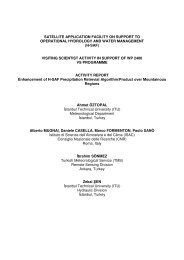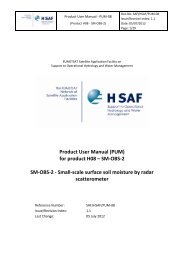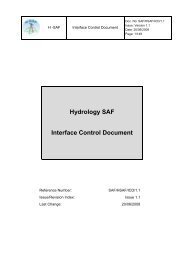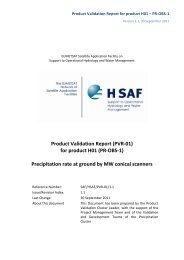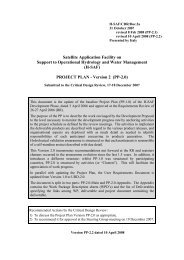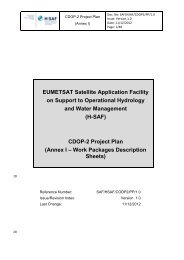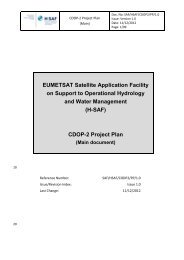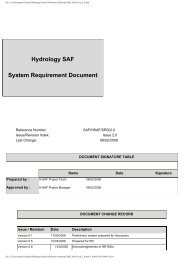H-SAF Product Validation Report (PVR) PR-OBS-3
H-SAF Product Validation Report (PVR) PR-OBS-3
H-SAF Product Validation Report (PVR) PR-OBS-3
You also want an ePaper? Increase the reach of your titles
YUMPU automatically turns print PDFs into web optimized ePapers that Google loves.
<strong>Product</strong>s <strong>Validation</strong> <strong>Report</strong>, 30 May 2010 - <strong>PVR</strong>-03 (<strong>Product</strong> <strong>PR</strong>-<strong>OBS</strong>-3) Page 38<br />
Fig. 29 - Meshed structure of the sample H02 product footprint.<br />
Determination of the W(r i,m ) weighting function in Equation 1 is crucial. In open literature, various<br />
approaches are proposed for determining this function. For instance, Thiebaux and Pedder 1987 11<br />
suggested weightings in general as,<br />
2 2<br />
R ri<br />
, m<br />
forri<br />
m<br />
R<br />
2 2<br />
,<br />
W ( r ) R r<br />
(2)<br />
i,<br />
m<br />
0<br />
forr<br />
i,<br />
m<br />
i,<br />
m<br />
R<br />
where R is the radius of influence, r is the distance from centre to the point and is a power parameter<br />
that reflects the curvature of the weighting function. Another form of geometrical weighting function<br />
was proposed by Barnes 1964 12 as,<br />
ri<br />
, m<br />
W ( ri<br />
, m)<br />
exp 4<br />
(3)<br />
R<br />
Unfortunately none of these functions are observation dependent but suggested on the basis of the<br />
logical and geometrical conceptualizations only. They are based only on the configuration, i.e. geometry<br />
of the measurement stations and do not take into consideration the natural variability of the<br />
meteorological phenomenon concerned. In addition, the weighting functions are always the same from<br />
site to site and time to time. However, in reality, it is expected that the weights should reflect to a certain<br />
extent the regional and temporal dependence behaviour of the phenomenon concerned.<br />
For the validation activities, the point cumulative semi-variogram technique proposed by Şen and Habib<br />
1998 13 is used to determine the spatially varying weighting functions. In this approach, the weightings<br />
not only vary from site to site, but also from time to time since the observed data is used. In this way,<br />
the spatial and temporal variability of the parameter is introduced more realistically to the validation<br />
activity.<br />
11 Thiebaux H.J. and M.A. Pedder, 1987: “Spatial objective analysis”. Academic Press, 299 pp.<br />
12 Barnes S.L., 1964: “A technique for maximizing details in numerical weather map analysis”. J. App. Meteor., 3,<br />
pp.396-409.<br />
13 Şen Z. and Z. Habib, 1998: “Point cumulative semivariogram of areal precipitation in mountainous regions”. Journal<br />
of Hydrology 205 (1–2), 81–91.




